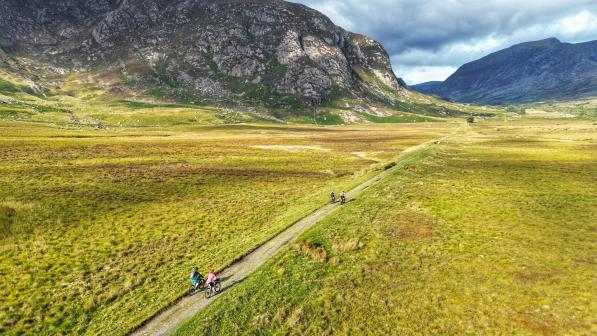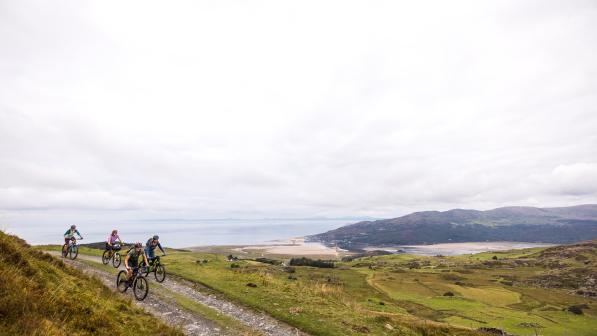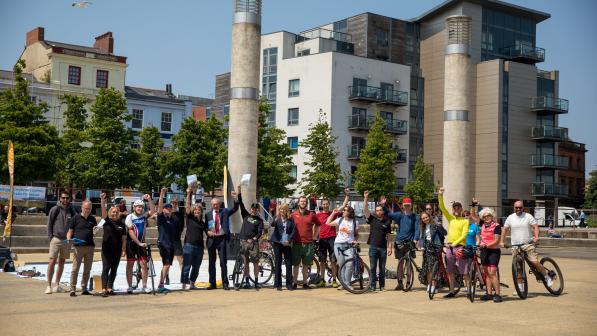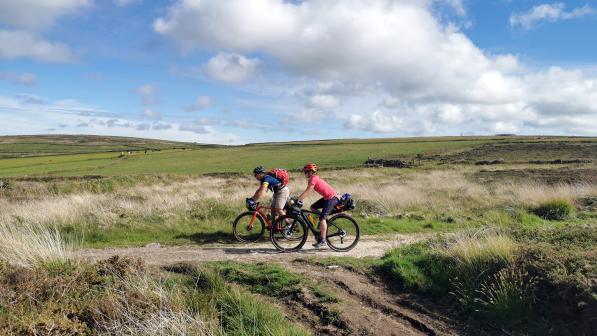Traws Eryri: the mysterious missing bits

Releasing the breath that I hadn’t noticed I was holding, I turned to look back at the old quarry incline that I’d just reached the bottom of. From this perspective the steep gradient seemed magnified, and I couldn’t quite believe that I’d ridden down it. I took a few deep breaths, waiting for the adrenaline to stop rushing around my system.
I turned my attention back to the scene in front of me. From the top of the incline I’d had a bird’s eye view of the remains of the quarry buildings laid out below, and now I was right up close to the engine house. It was almost eerie moving among these towering piles of slate, where what once would have been a hive of industrial activity has now fallen silent.
There’s something so visceral about experiencing historical places this way, as part of a journey by bike. You really appreciate the way they fit into the wider landscape.
We followed that with a fabulous descent down the track out of the quarry, with slate fragments tinkling beneath our wheels. One of my fellow riders turned to me beaming. “That was brilliant!” she said. “You have to keep that bit in.”

The challenge
Unfortunately, it was not to be. Test-riding the first draft version of Cycling UK’s Traws Eryri route back in September, we were hopeful that sections like this stunning disused quarry could be included on the route. Parts which didn’t have a recorded right of way for cycling, but which would be fantastic additions.
Creating long-distance off-road trails in Wales can be a challenge. Only 21% of rights of way are open for cycling, and they often don’t link up in a logical way. Often, it’s a frustratingly short connection which is missing: a bridleway which doesn’t connect to the road apart from via 200m of footpath, or a bit of forest track which doesn’t have formal public access.
In practice, some of these sections are well-used by local riders already, because without them you can’t link up your ride. However, to include them as part of Traws Eryri, we were aiming to secure landowner permission.
As we found, it’s complicated. The first hurdle is even tracking down who owns the land.
There is a section of Roman road on the hills near the coast, above Abergwyngregyn. It’s an ancient route on common land, so how do you find out who to ask?
The section through the old quarry near Llan Ffestiniog was a tricky one as well. When we managed to get hold of the right person at the quarry company which still operates part of it nearby, it turned out that they only leased it, and there were actually four different landowners over the two-mile stretch of path.
These discussions take a long time. Our route may be important to us and the people who want to ride it, but it’s bottom of the list for large landowner organisations. For some bits, the answer was a straight ‘no’. For most, we were chasing for many months to get an answer. At some point, we had to decide a cut-off point where we would finalise the route for now, and put it out into the world.
Altogether, it’s a culmination of several years of work by Cycling UK, Natural Resources Wales’s brilliant mountain bike ranger Andy Braund, and some really helpful input from local MTB guides. It’s not perfect, but it’s the route that’s possible now, with the inevitable compromises that come with our disjointed rights of way network.
The plot thickens
While researching and plotting potential connections on maps, we started to see signs of just how long some of these routes have been used by the public.
The Roman road near the north coast is one example. It’s an ancient trackway heading over the hills, which would have been a difficult journey before the alternative coastal road was built. People have travelled this way for millennia, but if you look at the map now it’s patchy at best: partly a byway, partly a footpath, and partly not a right of way at all.
There are also several old maps which describe a continuous route through the old quarry as a ‘mountain road’, rather than a footpath. There are layers of evidence indicating that it used to be classed as a road, and rights for cycling and horse riding still exist.
Cycling UK’s off-road adviser Kieran Foster has delved into the fascinating details of these historic routes, gathering evidence for a claim that these routes should have a higher status on the rights of way map.
You can explore some of this evidence in the story maps below.
Missing bits part 1 Missing bits part 2
The final Traws Eryri route is stunning, and cracking good fun. But isn’t quite the one we intended. There are still improvements we want to make to transform a great and enjoyable route into a truly incredible one.
We’re only able to create and evolve long-distance trails like Traws Eryri because of the support of people who love them. If you get excited whenever you hear news of a new trail, please donate to Cycling UK so we can continue to inspire people to discover amazing places by bike.



